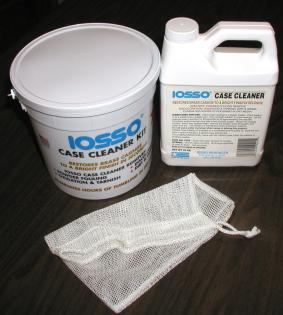 Sure, I know those vibratory cleaners can be fun. I know some of the best fun I had with mine was dropping a mouse in the open top, bolting on the screen cover, and watching the little guy disappear, and reappear, and disappear, and reappear, and… A downside to vibratory cleaning is the brain buzzing background sound when you’re trying to concentrate on a precise handloading task. The process also work hardens brass and eventually rounds off all those nicely squared case extraction and head spacing surfaces, ultimately reducing case life and possibly impairing firearm reliability. Plus, the process takes a lot of time to clear primer pockets, or powder residue inside cases. There are various media grades to buy and there is polishing compound and replenisher that needs to be added from time to time. Accordingly, I have pretty much changed over to detergent cleaners as a more effective, if a not less expensive, alternative for moderate cleaning duty.
Sure, I know those vibratory cleaners can be fun. I know some of the best fun I had with mine was dropping a mouse in the open top, bolting on the screen cover, and watching the little guy disappear, and reappear, and disappear, and reappear, and… A downside to vibratory cleaning is the brain buzzing background sound when you’re trying to concentrate on a precise handloading task. The process also work hardens brass and eventually rounds off all those nicely squared case extraction and head spacing surfaces, ultimately reducing case life and possibly impairing firearm reliability. Plus, the process takes a lot of time to clear primer pockets, or powder residue inside cases. There are various media grades to buy and there is polishing compound and replenisher that needs to be added from time to time. Accordingly, I have pretty much changed over to detergent cleaners as a more effective, if a not less expensive, alternative for moderate cleaning duty.When Birchwood Casey Brass Cartridge Case Cleaner became periodically difficult to locate, I began looking for a back up product and found IOSSO Case Cleaner, a product available through a number of online retailers. The starter kit comes with a quart of concentrate, a nylon net bag to hold the material being cleaned and a two quart pail to hold the combined cases and cleaner during the process. IOSSO is used in concentrated form, and Birchwood Casey cleaner is cut with water, which makes for a significant cost of cleaning difference. A 16 oz bottle of Birchwood Casey’s product makes 2 gallons of cleaner, costs approximately $10 and cleans approximately 8,000 cases; about a tenth of a cent per case, and it does a good job. By comparison, a quart IOSSO kit costs approximately $16 and will clean 2000 cases for a cost of about 1¢ a case. You do the math…actually, I guess I did the math. IOSSO is about ten times the cost of Birchwood Casey’s product, but neither product cost is high enough to put much of a dent in a wallet.
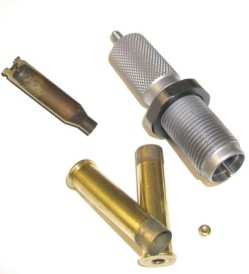 I decided to start with once fired .45-70 brass. There was typical straight case mouth residue, permanent marker used for cartridge identification and the usual primer pockets build up. Because of the large bore size, it would also be easy to see what sort of a cleaning job was being done on the inside as well as the outside surfaces. I also tossed in a cut away .243 Winchester case with heavy interior powder residue build up, so it would be easier to see how much of this gunk was removed.
I decided to start with once fired .45-70 brass. There was typical straight case mouth residue, permanent marker used for cartridge identification and the usual primer pockets build up. Because of the large bore size, it would also be easy to see what sort of a cleaning job was being done on the inside as well as the outside surfaces. I also tossed in a cut away .243 Winchester case with heavy interior powder residue build up, so it would be easier to see how much of this gunk was removed.I always decap and clean cases before doing any other work toward handloading. The approach makes for better inspection of fired brass, and it protects dies and other equipment from exposure to the transfer of abrasive powder and chemical residue. I set up the RCBS Rock Chucker with a universal decapping die and removed primers from 25 or so cases.
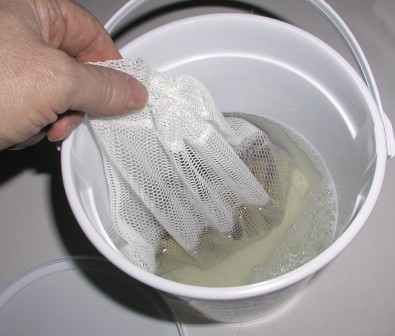
There isn’t a lot of mystery here, or many steps to tick off and follow. The cases are placed in the nylon mesh bag, the quart of cleaner is dumped in the bucket. The time noted for cleaning is 20 seconds to 5 minutes, with the caution progress should be observed to avoid leaving the cases in too long. Agitation, of the cases in solution, not state of mind, is recommended.
I don’t know why the call for a close watch, the cases and solution looked no different after 20 seconds, then they did at 7 minutes. T here was no hyper active progress in the works, and I didn’t think the cases were in jeopardy of being “over done”.
The solution is basically odorless, it does not irritate hands, and the solution itself didn’t even discolor very much from contamination. I could see the cases get progressively brighter and the powder residue did begin to wash away inside the bag in just a few moments. I did leave some in longer, 7 minutes, but they were no more clean than those left in for just 3 minutes.
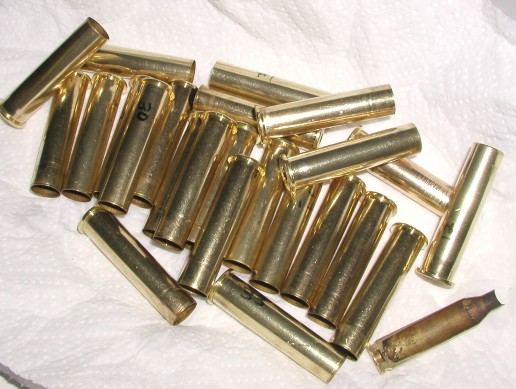
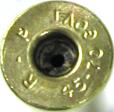 The cases came out bright, not stained and relatively clean inside. The indelible ink markings were barely disturbed. The .243 Winchester case, with very heavy interior deposits cleaned up nicely. Primer pockets were not spotless, but they usually aren’t spotless even after extensive vibratory cleaning. What remains after this process can be cleaned up mechanically, and very easily, prior to reloading. In regard to not getting a polished finish without running cases through abrasive cleaning media, the cases were bright, in fact they looked new.
The cases came out bright, not stained and relatively clean inside. The indelible ink markings were barely disturbed. The .243 Winchester case, with very heavy interior deposits cleaned up nicely. Primer pockets were not spotless, but they usually aren’t spotless even after extensive vibratory cleaning. What remains after this process can be cleaned up mechanically, and very easily, prior to reloading. In regard to not getting a polished finish without running cases through abrasive cleaning media, the cases were bright, in fact they looked new.The usefulness of household cleaners
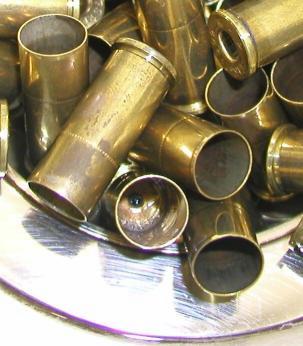
I use undiluted “Simple Green” for a lot of clean up tasks including: washing off recovered lead wheel weights before processing, removing black powder residue and preservative substance removal from new parts. I can usually locate it for under $7/gallon and, since I do have tree hugger friends, I can irritate them by telling them I use cleaner that is biodegradable.
In this case, I put undiluted Simple Green in a pail, once fired .44 Special cases in a mesh nylon bag, and agitated them every minute, for 20 minutes. The brass did not get any cleaner after the first couple of minutes, and this is how the brass looked after 20 minutes of soaking, then rinsed and dried. Interior and exterior powder residue was completely removed, virtually no residue was removed from primer pockets, and no tarnish or discoloration of brass was removed at all. Simple Green doesn’t interact with the brass as a chemical cleaner, but it is effective in removing burned powder deposits from case surfaces.
Birchwood Casey Brass Cartridge Case Cleaner
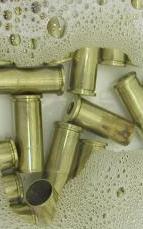
Just to make sure I wasn’t short changing Simple Green on it’s comparative ability to clean, I dumped more .44 Special cases from the same pile into Birchwood Casey, 2 ounces diluted into one quart of solution, and agitated the container at one minute intervals over a period of 20 minutes. As you can see through the suds, the cases generally were much cleaner, and the brass was bright, however, the heavy tarnish IOSSO seemed able to remove, still remained when treated only with Birchwood Casey. Primer pockets were almost clean enough to use as removed from the solution.
This batch of brass was heavily oxidized to a level that would not be an issue 99% of the time. They were handled, then put away in a sealed plastic bags for an extended period of time. After cleaning, the cases looked bad, but there was nothing that would cause a problem is use, no raised or sticky surfaces that would cause difficulty in chambering or extracting.
Vibratory Cleaning
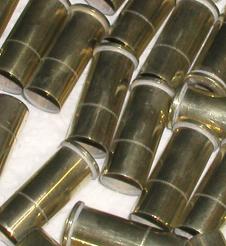 Just as a double check on chemical cleaning, I tossed yet another batch of these .44 Special cases into corn cob and polish media and let them buzz around in my RCBS machine for about an hour. When completed, the cases were relatively free of powder residue, the primer pockets and interior were also, but the tarnish was pretty much untouched; no better in this regard than Simple Green or Birchwood Casey Brass Cartridge Cleaner. So far, only IOSSO cleaner was able to remove this oxidation without special case preparation.
Just as a double check on chemical cleaning, I tossed yet another batch of these .44 Special cases into corn cob and polish media and let them buzz around in my RCBS machine for about an hour. When completed, the cases were relatively free of powder residue, the primer pockets and interior were also, but the tarnish was pretty much untouched; no better in this regard than Simple Green or Birchwood Casey Brass Cartridge Cleaner. So far, only IOSSO cleaner was able to remove this oxidation without special case preparation.On the right are clean cases, no oxidation or tarnish, and no powder residue. I was only able to get this result with the vibratory cleaner, by wiping down each case with a liquid brass polish and tarnish remover before dumping them back in the RCBS cleaner hopper for another full hour.
The best cleaner in terms of finished product, cost and time required ? It looks like IOSSO, but now I know to purchase the refill quart containers, about $10 per. I ordered my kit through Sinclair, but it can be purchased though almost decent online shooting supply business.
Thanks,
Joe

Email Notification